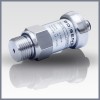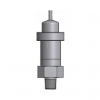Instrumentation that has a I²C (Inter-Integrated Circuit) serial computer bus interface for inter-connection & compatibility with other I²C components.
Products
 DCT 532 I²C Pressure Sensor for TWI Communication - The DCT532 I²C pressure sensor has a I²C serial computer bus protocol interface for sending pressure readings over addressable digital communications.
DCT 532 I²C Pressure Sensor for TWI Communication - The DCT532 I²C pressure sensor has a I²C serial computer bus protocol interface for sending pressure readings over addressable digital communications. Chemical Resistant Pressure Sensor Elements for Electronic Devices & Embedded Product Design & Development - Pressure sensor elements with sensing diaphragms made from alumina ceramic (Al2O3) for electronic & mechanical oem integration into measurement & control instrumentation designs.
Chemical Resistant Pressure Sensor Elements for Electronic Devices & Embedded Product Design & Development - Pressure sensor elements with sensing diaphragms made from alumina ceramic (Al2O3) for electronic & mechanical oem integration into measurement & control instrumentation designs.
Applications
 10 bar absolute I2C interface air pressure sensor - An absolute digital pressure sensor for measuring the pressure of air over a range of 0 to 10 bar absolute from the G1/4 male process connection, and sending the corresponding I2C interface through the weatherproof cable gland electrical connection.
10 bar absolute I2C interface air pressure sensor - An absolute digital pressure sensor for measuring the pressure of air over a range of 0 to 10 bar absolute from the G1/4 male process connection, and sending the corresponding I2C interface through the weatherproof cable gland electrical connection.
